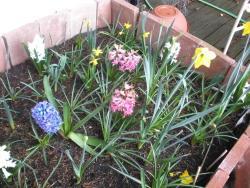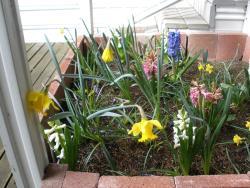I just learned: If I quote
someone else who flagged my name as "@RickCorey", I get a system notice that "Rick Corey flagged your name in a post".
Post #1227889 (12)
And now I'll get another.
I know that it is very wide-spread to say not to add to add sand to clay soil. But since the only "why" given is a cute reference to concrete (which is made with MORTAR and aggregate like crushed stone plus large gravel - not clay). That never impressed me. Argument by analogy is for poets, not scientists or engineers, farmers or gardeners.
If they had said "adding sand OR GRIT to clay soil that has ALMOST NO COMPOST OR VERY LITTLER COMPOST does not help much", I would agree with them. But what that really means is: "clay soil needs compost!"
AFTER you've added ALMOST ENOUGH compost to lighten the clay soil significantly, THEN try adding 15-20% very coarse sand
and grit.
Then believe that the results you get under your own conditions are the answers that are most relevant to your garden.
What I
see when I do it in my yard contradicts the cute sound bite that I hear repeated over and over.
So I go by what I see, not what I hear.
>> When I do this, I replace almost all of the clay, so only maybe 10-15% of the soil that is left is clay
I also
remove all the soil from my "raised and sunken" beds, so I can slope the "floor" towards a slit trench that utilizes the grade to escort water from the sunken part of the bed to a lower part of my yard.
But then I screen it repeatedly to break up the clay balls and mix the clay with compost, bark, grit and sand. I amend it with as much of these as I can: compost, crushed stone, bark fines and even sometimes the coarsest sand I can find.
I add very roughly as much amendments as clay soil. For my best beds, more than 50% amendments. When I run short, maybe only 30% amendments ... but that isn't enough.
I think I start with "clay soil" that's at least 60-70% clay and 0% organic. I amend it until I wind up with maybe 30-40% clay, 30% bark fines and undigested compost fibers, at most 10% grit + sand, plus as much compost as I can afford (up to 20%? I wish I had 50% compost, plus another 3-4" to add every year.)
I let it "digest" for some weeks or months if I'm patient, before dumping it back below grade (but trenched). That also lets me watch it settle while it "digests" and decide whether I need to buy more bark and compost. Crushed rock and sand are SO expensive and heavy that I very seldom get more than 10% sand and grit added. But when I really need good drainage, like one well-drained square yard for bulbs, I use a lot more grit and bark, and then it drains great for around 1.5 to two years.
(After the compost and bark are digested, I have to fluff it up a again and add more compost. Maybe that's what scientists really mean when they say "don't". But until I find their papers, I can't really comment on the reasons for their conclusions.)
When I added a lot of crushed stone and bark and compost and a little sand, pure dead clay gave me excellent drainage for two years, then it subsided by almost a factor of two. Things will still grow in it, but it's HEAVY again. And my solution for subsidence would have been more crushed stone!



